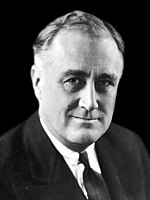| ||||||||||||||||||||||||||
All 13 North Carolina votes to the Electoral College | ||||||||||||||||||||||||||
|---|---|---|---|---|---|---|---|---|---|---|---|---|---|---|---|---|---|---|---|---|---|---|---|---|---|---|
| ||||||||||||||||||||||||||
 County Results
| ||||||||||||||||||||||||||
| ||||||||||||||||||||||||||
| Elections in North Carolina |
|---|
 |
The 1936 United States presidential election in North Carolina took place on November 3, 1936, as part of the 1936 United States presidential election. North Carolina voters chose 13[2] representatives, or electors, to the Electoral College, who voted for president and vice president.
As a former Confederate state, North Carolina had a history of Jim Crow laws, disfranchisement of its African-American population and dominance of the Democratic Party in state politics. However, unlike the Deep South, the Republican Party had sufficient historic Unionist White support from the mountains and northwestern Piedmont to gain a stable one-third of the statewide vote total in most general elections,[3] where turnout was higher than elsewhere in the former Confederacy due substantially to the state's early abolition of the poll tax in 1920.[4] A rapid move following disenfranchisement to a completely “lily-white” state GOP also helped maintain Republican support amongst the state's voters.[5] Like Virginia, Tennessee and Oklahoma, the relative strength of Republican opposition meant that North Carolina did not have statewide white primaries, although certain counties did use the white primary.[6]
Anti-Catholicism against 1928 Democratic nominee Al Smith in the fishing communities of the Outer Banks, alongside increasing middle-class Republican voting in such cities as Charlotte, Durham and Greensboro,[7] meant that Republican nominee Herbert Hoover would use the lily-white state party to win its electoral votes for the first time since the Reconstruction election of 1872. During Hoover's administration, the state became the scene of a major controversy in the Supreme Court nomination of Fourth Circuit judge and 1920 Republican gubernatorial candidate John Johnston Parker, who had said that black North Carolinians no longer desire to participate in politics. When he was nominated the National Association for the Advancement of Colored People sent letters to senators requesting Parker's defeat.[8] The NAACP would ultimately succeed in defeating Parker, being helped by many Southern Democrats who feared that his nomination would strengthen a newly lily-white Republican Party in the former Confederacy, by many Northern and Border State Republicans opposed to a lily-white GOP there, and by the hostility of the American Federation of Labor to some of his rulings.[9] The Parker defeat put an end to Republican efforts to breach the “Solid South” for over two decades, and in North Carolina the two Republican congressmen elected in 1928 would both be defeated in 1930.
Although North Carolina suffered the smallest relative income loss of any state as a result of the Depression,[10] many Southerners blamed the collapse on the North and on Wall Street.[11] it had extremely severe effects in the South, which had the highest unemployment rate in the nation, and many Southerners blamed this on the North and on Wall Street, rejecting Hoover's claim that the Depression's causes were exogenous.[11] As expected,[12] North Carolina returned to the “Solid South” in 1932, and despite the entrenched conservatism of its Democratic leadership, the majority of the state's electorate revered President Franklin D. Roosevelt.[13] In October 1936, a poll had Roosevelt winning 65 percent of the state's ballots against Republican nominees Kansas Governor Alf Landon and Frank Knox.[14] Another poll a week before the election said the state was sure to back FDR despite known doubts about the New Deal amongst voters.[15]
Ultimately North Carolina was won by Roosevelt with 73.40 percent of the popular vote, against Landon's 26.60 percent.[16][17] This was an improvement of over three points upon FDR's 1932 performance, produced by gains of double digits in the urban Piedmont counties of Durham and Alamance, and lesser gains in neighbouring counties.[18] Landon retained the loyal GOP Unionist strength, with Avery County advancing from the tenth-most Republican in 1932 to being Landon's fifth-strongest county four years later.[19]
- ^ "United States Presidential election of 1936 – Encyclopædia Britannica". Retrieved December 25, 2018.
- ^ "1936 Election for the Thirty-eighth Term (1937-41)". Retrieved December 25, 2018.
- ^ Phillips, Kevin P.;The Emerging Republican Majority, pp. 210, 242 ISBN 978-0-691-16324-6
- ^ Key, Valdimer Orlando; Southern Politics in State and Nation, p. 502, Alfred A. Knopf (1949)
- ^ Heersink, Boris; Jenkins, Jeffery A. (2020). Republican Party Politics and the American South, 1865–1968. Cambridge University Press. pp. 48–50, 239–243. ISBN 9781316663950.
- ^ Klarman, Michael J. (2001). "The White Primary Rulings: A Case Study in the Consequences of Supreme Court Decision-Making". Florida State University Law Review. 29: 55–107.
- ^ Phillips; The Emerging Republican Majority, pp. 212-215
- ^ Goings, Kenneth W. (1990). The NAACP comes of age: the defeat of Judge John J. Parker. Indiana University Press. pp. 23–24. ISBN 0253325854.
- ^ Topping, Simon (2008). Lincoln's lost legacy: the Republican Party and the African American vote, 1928-1952. Gainesville, Florida: University Press of Florida. p. 22. ISBN 978-0813032283.
- ^ Abrams, Douglas Carl (1992). Conservative constraints: North Carolina and the New Deal. Jackson, Mississippi: University Press of Mississippi. p. 3. ISBN 9780878055593.
- ^ a b Ritchie, Donald A. (2007). Electing FDR: the New Deal campaign of 1932. Lawrence, Kansas: University Press of Kansas. p. 143. ISBN 978-0700616879.
- ^ Lewinson, Paul (1965). Race, class and party; a history of Negro suffrage and white politics in the South. pp. 167–168.
- ^ Abrams. Conservative Constraints, p. 47
- ^ Gallup, George (October 11, 1936). "Democratic Gains, Losses Since January". St. Louis Globe-Democrat. p. 1B.
- ^ Lawrence, David (October 26, 1936). "N. Carolina for Roosevelt but Has Doubts About New Deal". The Indianapolis News. p. 4.
- ^ "1936 Presidential General Election Results – North Carolina". Retrieved December 25, 2018.
- ^ "The American Presidency Project – Election of 1936". Retrieved December 25, 2018.
- ^ "NC US President Race, November 03, 1936". Our Campaigns.
- ^ "1936 Presidential Election Statistics". Dave Leip’s U.S. Election Atlas.

